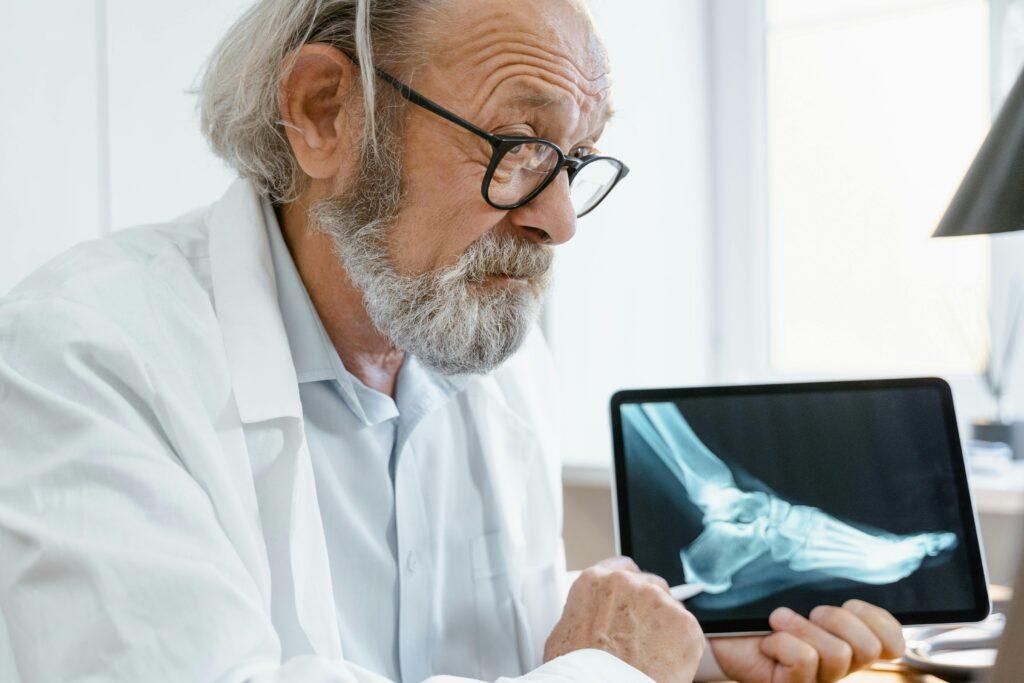Introduction to Fracture Classification Systems
AO fracture classification system help orthopedic surgeons diagnose, plan treatment, and predict outcomes for bone injuries. While many eponymous systems exist for specific fractures, the AO Foundation (Arbeitsgemeinschaft für Osteosynthesefragen) developed a universal, alphanumeric classification system—now widely adopted by groups like the Orthopaedic Trauma Association (OTA).
This guide explains the AO fracture classification system, covering diaphyseal (shaft) and metaphyseal (joint-related) fractures, their severity levels, and clinical significance.

The AO Fracture Classification System: Structure & Codes
The AO system uses a structured, formulaic approach to categorize fractures. Here’s how it works:
1. Bone Identification (Number Codes)
Each bone is assigned a number:
- 1: Humerus
- 2: Radius & ulna
- 3: Femur
- 4: Tibia & fibula
- 44: Ankle (special case)
2. Fracture Location
(Region Codes)
- 1: Proximal metaphysis (near joint)
- 2: Diaphysis (bone shaft)
- 3: Distal metaphysis
3. Fracture Type
(A, B, or C – Increasing Severity)
- Type A: Simple fractures (best prognosis)
- Type B: Moderate complexity (e.g., wedge/butterfly fractures)
- Type C: Severe, complex fractures (worst prognosis)
4. Group & Subgroup
(Further Complexity Breakdown)
- Groups (1, 2, 3): Indicate increasing fracture complexity.
- Subgroups (.1, .2, .3): Used for research (less reliable in practice).
AO Classification of Diaphyseal (Shaft) Fractures
Type A: Simple Fractures (Two-Part Breaks)
- A1: Spiral fracture
- A2: Oblique fracture
- A3: Transverse fracture
Why Spiral Fractures Heal Faster:
Despite instability, their large surface area promotes faster bone healing.
Type B: Wedge (Butterfly) Fractures
- B1: Spiral wedge
- B2: Bending wedge
- B3: Fragmented wedge
Key Feature: Some contact remains between main fragments.
Type C: Comminuted (Multi-Fragmentary) Fractures
- C1: Spiral comminution
- C2: Segmental fracture
- C3: Irregular, highly fragmented
Clinical Challenge: No contact between main fragments → harder to fix.
AO Classification of Metaphyseal (Near-Joint) Fractures
Type A: Extra-Articular (Joint Not Affected)
- A1: Simple fracture
- A2: Impacted fracture
- A3: Comminuted fracture
Type B: Partial Articular (Part of Joint Involved)
- B1: Pure split (sagittal/coronal)
- B2: Split with depression
- B3: Multi-fragmentary partial articular
Type C: Complete Articular (Joint Surface Destroyed)
- C1: Simple articular + simple metaphysis
- C2: Simple articular + complex metaphysis
- C3: Complex articular + complex metaphysis
Surgical Priority: Type C fractures often require open reduction & internal fixation (ORIF) to restore joint function.
Why the AO System Matters in Orthopedics
- Standardized Communication – Ensures clear terminology among surgeons.
- Treatment Planning – Helps decide between casting vs. surgery.
- Prognosis Prediction – Type A fractures heal better than Type C.
- Research & Data Collection – Allows consistent fracture studies.
Conclusion: Mastering Fracture Classification
The AO fracture classification system is a gold standard in orthopedics, offering a detailed, universal method to categorize bone injuries. Whether dealing with a simple diaphyseal break (Type A1) or a complex intra-articular fracture (Type C3), this system guides diagnosis, treatment, and recovery expectations.
Examples:
1: Femur Shaft Fracture (32-A1)
- Bone: 3 (Femur)
- Region: 2 (Diaphysis/shaft)
- Type: A (Simple fracture)
- Group: 1 (Spiral pattern)
Clinical Scenario:
A 25-year-old skier falls and twists their leg, resulting in a spiral femoral shaft fracture.
Why AO Matters: - Predicts fast healing (large surface area)
- May allow intramedullary nailing instead of plating
2: Distal Radius Fracture (23-C2)
- Bone: 2 (Radius/ulna)
- Region: 3 (Distal metaphysis)
- Type: C (Complete articular)
- Group: 2 (Complex metaphysis + simple joint break)
Clinical Scenario:
An elderly patient falls onto an outstretched hand, causing a comminuted distal radius fracture extending into the wrist joint.
Why AO Matters: - Flags need for CT scan (articular involvement)
- Guides surgery: ORIF with volar plate
3: Tibial Plateau Fracture (41-B3)
- Bone: 4 (Tibia/fibula)
- Region: 1 (Proximal metaphysis)
- Type: B (Partial articular)
- Group: 3 (Multifragmentary depression)
Clinical Scenario:
A car accident victim suffers a lateral tibial plateau fracture with depressed joint fragments.
Why AO Matters: - Indicates risk of post-traumatic arthritis
- Requires bone graft + buttress plating
4: Open Ankle Fracture (44-C3)
- Special Code: 44 (Ankle)
- Type: C (Complete articular)
- Group: 3 (Severe comminution)
Clinical Scenario:
A construction worker jumps from height, sustaining a pilon fracture with ankle joint destruction.
Why AO Matters: - Warrants staged surgery (external fixator first)
- Predicts long recovery (6+ months)
Also read:
Read further from trusted sources:
AO Foundation’s official fracture classification guidelines (https://www.aofoundation.org)
OTA’s adaptation of the AO classification system (https://ota.org)
JOT study on AO Type C fracture outcomes (https://journals.lww.com/jorthotrauma)
Radiopaedia’s AO fracture imaging guide (https://radiopaedia.org/articles/ao-classification)
NIH resources on metaphyseal fracture healing (https://www.bones.nih.gov)
Wheeless’ AO classification surgical protocols (https://www.wheelessonline.com)